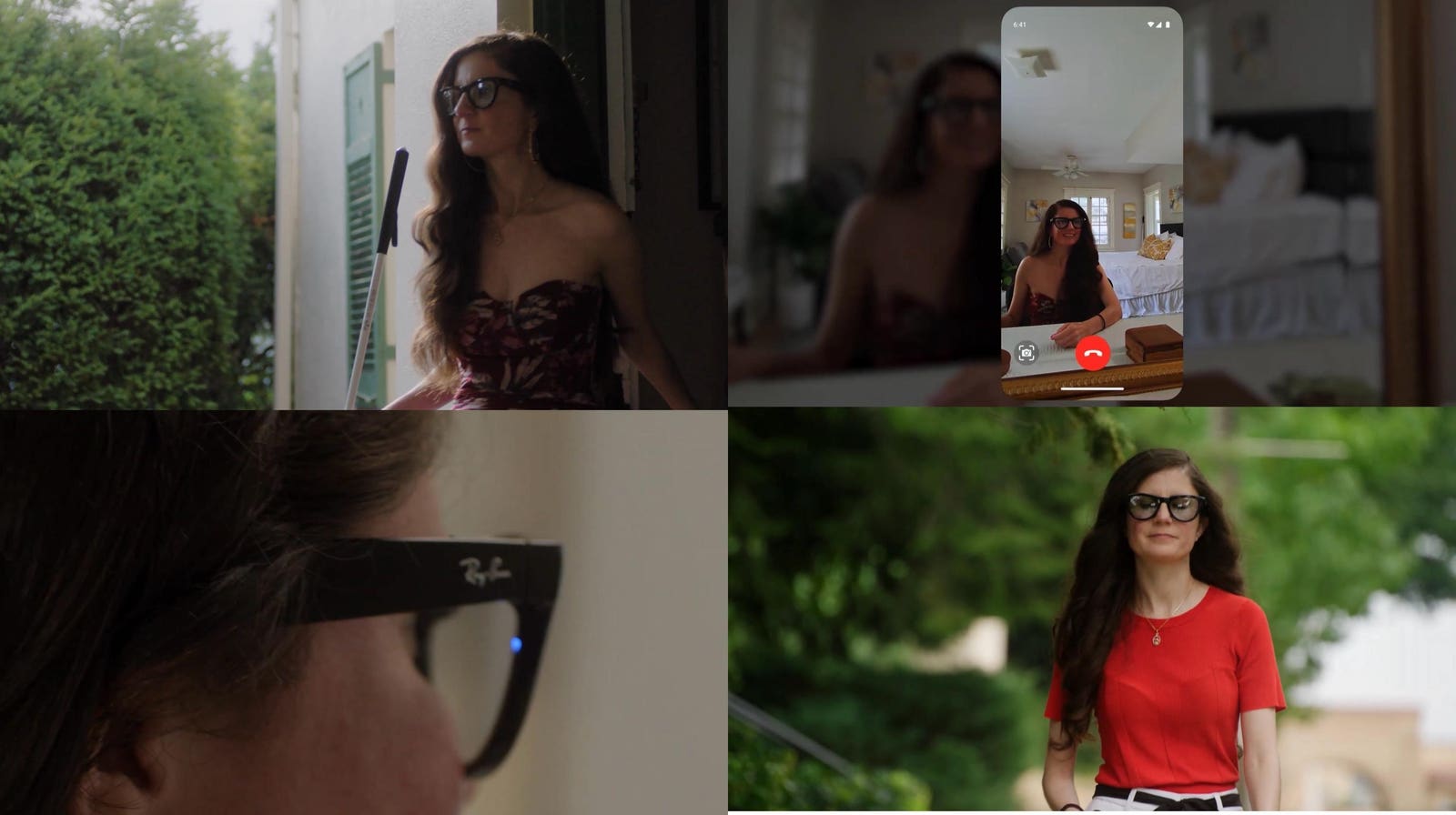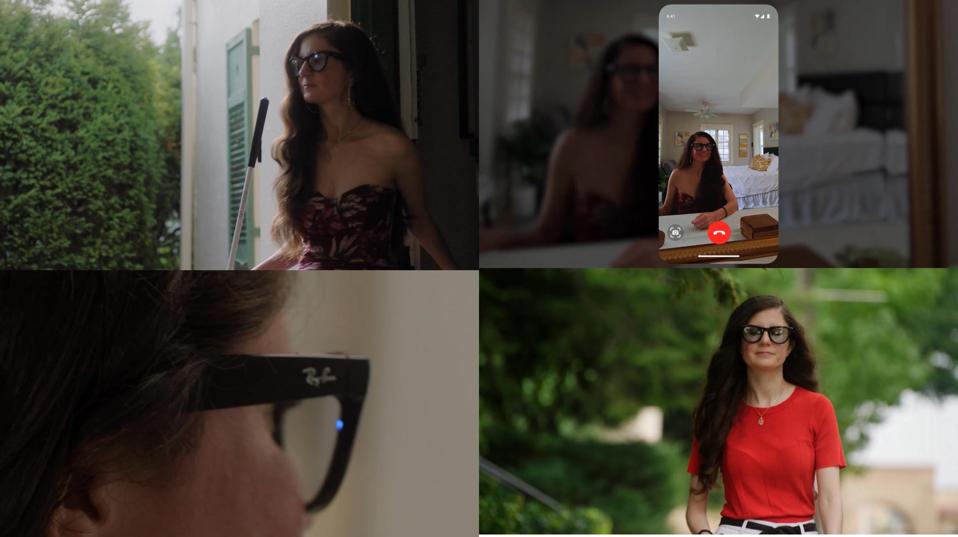A blind woman uses a white cane and Ray-Ban Meta smart glasses, reflecting how wearable technology is expanding accessibility.
Be My Eyes and Meta
I did not expect to write about Meta. But I could not ignore what these glasses are starting to unlock. That made me take a second look at Ray-Ban Meta smart glasses.
They are not branded as assistive tech. But by blending voice control, audio, and camera functionality into something people already wear, cool and stylish eyewear, they unlock new kinds of usability for all, especially for those of us navigating hearing loss, vision differences, or limited dexterity.
At the same time, Meta’s hardware partner EssilorLuxottica is stepping forward in its own right. Though completely separate from Ray-Ban Meta, the company’s Nuance Audio hearing glasses signal its first direct entry into hearing support. They take cues from lifestyle design to normalize everyday use. While the two products serve different needs and have no technical overlap, they represent something shared: a shift toward inclusive design at the scale of daily life.
I have worked in accessibility for decades. I know progress when I see it. It does not always come from the companies you expect. But when it arrives, and it works for more people, more naturally, it deserves a closer look.
Ray-Ban Meta is not about hype. It is about what is possible.
Why Ray-Ban Meta Matters for Real-World Access
Meta has positioned itself at the center of emerging technologies. It talks about connection, presence, and immersion. But until now, much of that vision has remained out of reach for many people, especially those who need tools that adapt to their physical or sensory realities.
Ray-Ban Meta smart glasses represent something different. They are not meant for a niche. They are not experimental hardware for early adopters. They are designed for anyone to wear daily. That is the shift.
The features are surprisingly practical: open-ear directional speakers that do not block ambient sound, five built-in microphones that can pick up your voice even in a noisy space, a 12-megapixel camera, Meta AI that responds to your voice, and all of it in a familiar form.
These features make everyday tasks more fluid: reading a sign, taking a hands-free call, listening to a message while crossing the street, and capturing a moment without fumbling for your phone.
But look closer, and the accessibility implications begin to emerge. For someone with low or no vision, the ability to point your head and hear what is in front of you without taking out a phone or using both hands changes the interaction entirely. For someone with limited dexterity, the ability to command a device through voice alone can mean greater autonomy. Reducing the number of steps to complete a task can help conserve energy for someone managing cognitive load or fatigue.
Meta may not have set out to design an accessibility tool. However, by focusing on natural interaction, not screens or buttons, the glasses open the door to new ways of participating in the world. That shift, whether intentional or not, makes them worth a closer look.
From Everyday Convenience to Real-World Access
That potential becomes even more powerful when paired with human insight and real-world use. That is precisely what Be My Eyes is delivering.
Founded in Denmark in 2015, Be My Eyes is more than an app. It has become an essential mobile experience for many blind and low-vision users, a go-to tool for accessing the visual world through real-time human connection. The platform supports nearly 1 million users and is powered by over 8.8 million sighted volunteers who offer assistance via live video calls. It has expanded recently to include AI-based support and deep integrations with companies like Microsoft, Google, and Meta. These partnerships are now bringing their services into more contexts, including wearables like the Ray-Ban Meta glasses.
I recently spoke with Mike Buckley, CEO of Be My Eyes. With Ray-Ban Meta, he explained, the service moves from the palm of your hand to the bridge of your nose. Real-time environmental information, object recognition, and volunteer support are now available without lifting a finger. Mike shared:
“Think about these glasses. Not as a device, but as power, and think about them as the prospect for phenomenally greater independence. Economic independence through employment, right? That excites me, which is why it is important.”
He is right. These glasses are not just about seeing. They are about working, moving, and thriving. This technology can shift hesitation into confidence in fast-paced workplaces or unfamiliar environments. And for many people, that shift matters.
Be My Eyes Makes “Vision” Work
The more I work in this field, the more I see that hearing, seeing, and sensing are not separate challenges. They are all part of how we connect with the world and each other.
Ray-Ban Meta and Nuance Audio may meet different needs but point to the same reality. People want to live fully without wearing technology that singles them out. They want tools that blend into their lives, not define them.
What stands out now is this. While Meta and EssilorLuxottica are the brands behind the Ray-Ban Meta glasses, the real breakthrough is Be My Eyes. They are not just adding functionality. They are changing how vision support is delivered as something intuitive, integrated, and empowering. With a simple voice command, “Call a volunteer,” they have transformed smart glasses into a tool for independence, dignity, and connection. And they have done it at scale.
This is not just about innovation. It is about expanding who can participate and making accessibility part of everyday life.
What This Progress Signals for the Market
Some of the most meaningful technological advances are not about what is announced. The real value lies in seeing how a product, when combined with the right purpose and partnership, can reshape millions’ participation. That is what deserves our attention.
Meta may not have built its brand on accessibility. But this direction offers intuitive use, and meets people where they are, suggests a change worth watching. And EssilorLuxottica’s parallel effort with Nuance Audio adds momentum to that change.
I do not expect perfection from any brand. But I look for signs of possibility, especially when they come from companies willing to evolve their offerings to serve more people, more intuitively. EssilorLuxottica’s expansion into hearing wellness and Meta’s shift toward wearable utility reflect new business bets that could help redefine accessibility as a business priority, not an afterthought.

